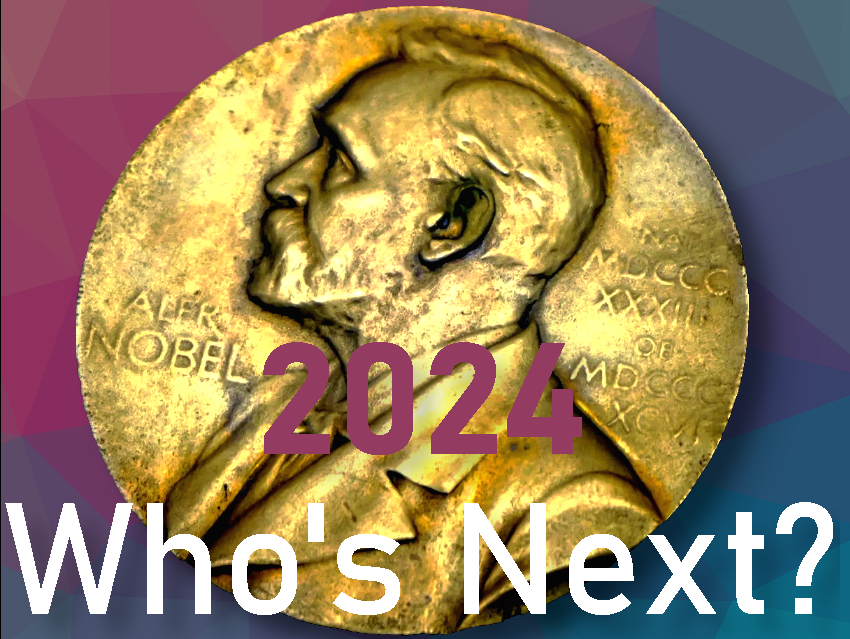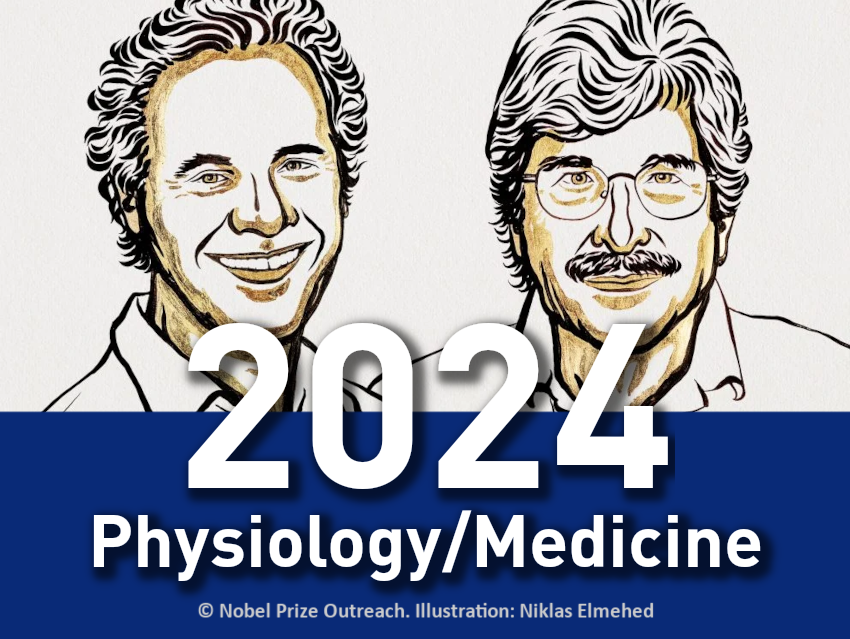The 2024 Nobel Prize in Physiology or Medicine has been awarded to
- Victor Ambros and Gary Ruvkun from the University of Massachusetts Medical School, Worcester, MA, USA,
for “the discovery of microRNA and its role in post-transcriptional gene regulation” [1].
MicroRNAs are tiny RNA molecules that regulate gene activity in various organisms, including humans. Their work has significantly advanced the understanding of gene regulation and has transformative implications for health and disease, the Nobel Committee said.
The surprising discovery of microRNAs by Ambros and Ruvkun unveiled an evolutionarily conserved post-transcriptional regulatory mechanism with critical roles in both animal development and adult tissue function.
1 Research
The regulation of gene expression allows cells to increase or decrease the generation of products such as specific proteins. Instructions for precise, cell-type-specific gene regulation are encoded in the genetic material itself and involve sequence-specific DNA-binding proteins. Additional layers of gene regulation have emerged within multicellular organisms to ensure the correct production of RNA and proteins at any given time in each cell-type. To exert control over mRNA stability and protein translation after transcription, genes encoding tiny, non-coding RNA molecules, so-called microRNAs, expanded within the genomes of multicellular organisms.
1.1 Micro-RNAs and Mutant Nematodes
MicroRNAs and their mode of gene regulation had been unknown until their discovery by Victor Ambros and Gary Ruvkun in 1993. The two Nobel Laureates studied mutant Caenorhabditis elegans (C. elegans) nematodes that had developmental defects caused by alterations at certain genetic loci called lin-4 and lin-14. Their research focused on how these mutations affect growth and development in these tiny roundworms.
In the lin-4 mutant, a major disruption of worm development had been observed, and many cell types and morphological structures were entirely absent[bnp][2,3]. The major disruption of worm development observed in the lin-4 mutant suggested that lin-4 encoded a “master regulator” of developmental timing. A large number of additional “heterochronic” mutants (meaning those with a difference in the timing of developmental processes) showing various developmental defects were characterized, including a second mutant, lin-14.
1.2 The Path to Ambros’ and Ruvkun’s Discovery
Ambros identified that lin-14 has developmental timing defects that were opposite to those observed in the lin-4 mutant. In lin-14 mutants, “larval programs” were completely absent [4]. He cloned the lin-4 gene and made the surprising discovery that it did not code for a protein. Instead, it encoded a short, 22-nucleotide-long noncoding RNA.
In parallel, Ruvkun demonstrated that lin-14 is a nuclear protein with stage-specific expression in development that is altered in lin-4 and lin-14 mutants [5]. Ruvkun determined that lin-4 regulates lin-14 via multiple elements in its 3′ untranslated region (3’UTR) [6]. Upon comparing sequence information, the two researchers defined partial sequence complementarity between the short non-coding lin-4 RNA and the 3’UTR elements of lin-14. This provided a first glimpse into a conceptually novel type of regulatory RNAs: microRNAs [7,8].
1.3 More MicroRNAs?
In 2000, Ruvkun discovered a second microRNA gene, called let-7 [9]. Let-7 encodes a short 21-nucleotide RNA that showed complementarity to 3’UTRs of various heterochronic genes, including lin-14.
The finding of a second microRNA gene suggested that microRNAs may play a broader role in regulating stage-specific timing of cell lineage formation during development.
This discovery led to the identification of homologous microRNAs across diverse animal species, including humans. This sparked intense cloning and sequencing efforts to identify microRNAs across the animal kingdom. This led to the finding that microRNAs represent a large group of regulators that control extensive networks of protein-coding genes.
2 Laureates
Victor Ambros, born in 1953 in Hanover, NH, USA, studied biology at the Massachusetts Institute of Technology (MIT), Cambridge, MA, USA, graduating in 1975. He completed his Ph.D. in 1979 at the same university under the supervision of Nobel Laureate David Baltimore. After completing postdoctoral work in the lab of future Nobel Laureate H. Robert Horvitz at MIT, he became a faculty member at Harvard University, Cambridge, MA, USA, in 1984 and moved to Dartmouth College, Hanover, NH, USA, in 1992.
Victor Ambros joined the faculty at the University of Massachusetts Medical School in 2008 and currently holds the title of Silverman Professor of Natural Sciences in the program in Molecular Medicine, endowed by his former Dartmouth student, Howard Scott Silverman.
Among many other honors, Victor Ambros was awarded the Breakthrough Prize in Life Sciences in 2015, the Wolf Prize for Medicine in 2014 together with Gary Ruvkun, the Lasker Award for Basic Medical Research in 2008, the Gairdner Foundation International Award in 2008, and the Benjamin Franklin Medal in Life Science in 2008.
Gary Ruvkun, born in 1952 in Berkeley, CA, USA, studied at the University of California, Berkeley, and received his Ph.D. from Harvard University, Cambridge, MA, USA, in the laboratory of Frederick M. Ausubel, where he investigated bacterial nitrogen fixation genes. After completing post-doctoral studies with Robert Horvitz at the Massachusetts Institute of Technology (MIT), Cambridge, MA, USA, and Walter Gilbert at Harvard, he joined Harvard Medical School in 1985, where he serves as Professor of Genetics today while also working as a Molecular Biologist at Massachusetts General Hospital.
Among many other honors, Gary Ruvkun was awarded the Breakthrough Prize in Life Sciences in 2015, the Wolf Prize for Medicine in 2014 together with Victor Ambros, the Lasker Award for Basic Medical Research in 2008, the Gairdner Foundation International Award in 2008, and the Benjamin Franklin Medal in Life Science in 2008.
References
[1] Website of the The Nobel Foundation nobelprize.org
[2] H. Robert Horvitz, John E. Sulston, Isolation and Genetic Characterization of Cell-Lineage Mutants of the Nematode Caenorhabditis elegans, Genetics 1980, 96, 435–454.https://doi.org/10.1093/genetics/96.2.435
[3] Martin Chalfie, H. Robert Horvitz, John E. Sulston, Mutations that lead to reiterations in the cell lineages of C. elegans, Cell 1981, 24, 59–69. https://doi.org/10.1016/0092-8674(81)90501-8
[4] Victor Ambros, H. Robert Horvitz, Heterochronic Mutants of the Nematode Caenorhabditis elegans, Science 1984, 226, 409–416. https://doi.org/10.1126/science.64948
[5] Gary Ruvkun, John Giusto, The Caenorhabditis elegans heterochronic gene lin-14 encodes a nuclear protein that forms a temporal developmental switch, Nature 1989, 338, 313–319. https://doi.org/10.1038/338313a0
[6] B. Wightman, T. R. Bürglin, J.Gatto, P. Arasu, G. Ruvkun, Negative regulatory sequences in the lin-14 3′-untranslated region are necessary to generate a temporal switch during Caenorhabditis elegans development, Genes Dev.t 1991, 5, 1813–1824. https://doi.org/10.1101/gad.5.10.1813
[7] Rosalind C. Lee, Rhonda L. Feinbaum, Victor Ambros, The C. elegans Heterochronic Gene lin-4 Encodes Small RNAs with Antisense Complementarity to lin-14, Cell 1993, 75, 843–854. https://doi.org/10.1016/0092-8674(93)90529-y
[8] Bruce Wightman, llho Ha, Gary Ruvkun, Posttranscriptional Regulation of the Heterochronic Gene lin-14 by W-4 Mediates Temporal Pattern Formation in C. elegans, Cell 1993, 75, 855–862. https://doi.org/10.1016/0092-8674(93)90530-4
[9] Brenda J. Reinhart, Frank J. Slack, Michael Basson, Amy E. Pasquinelli, Jill C. Bettinger, Ann E. Rougvie, H. Robert Horvitz, Gary Ruvkun, The 21-nucleotide let-7 RNA regulates developmental timing in Caenorhabditis elegans, Nature 2000, 403, 901–906. https://doi.org/10.1038/35002607
Selected Publications
Selected Publications by Victor Ambros
- Victor Ambros, MicroRNAs and developmental timing, Curr. Opin. Genet. Dev. 2011, 21, 511–517. https://doi.org/10.1016/j.gde.2011.04.003
- Dang Long, Rosalind Lee, Peter Williams, Chi Yu Chan, Victor Ambros, Ye Ding, Potent effect of target structure on microRNA function, Nat. Struct. Mol. Biol. 2007, 14, 287–294. https://doi.org/10.1038/nsmb1226
- Victor Ambros, Xuemei Chen, The regulation of genes and genomes by small RNAs, Development 2007, 134, 1635–1641. https://doi.org/10.1242/dev.002006
- Eric A. Miska, Ezequiel Alvarez-Saavedra, Allison L. Abbott, Nelson C. Lau, Andrew B. Hellman, Shannon M. McGonagle, David P. Bartel, Victor R. Ambros, H. Robert Horvitz, Most Caenorhabditis elegans microRNAs Are Individually Not Essential for Development or Viability, PLOS Genet. 2007. https://doi.org/10.1371/journal.pgen.0030215
- Arti Gaur, David A. Jewell, Yu Liang, Dana Ridzon, Jason H. Moore, Caifu Chen, Victor R. Ambros, Mark A. Israel, Characterization of MicroRNA Expression Levels and Their Biological Correlates in Human Cancer Cell Lines, Cancer Res. 2007, 67, 2456–2468. https://doi.org/10.1158/0008-5472.CAN-06-2698
Selected Publications by Gary Ruvkun
- Eyleen J. O’Rourke, Alexander A. Soukas, Christopher E. Carr, Gary Ruvkun, C. elegans Major Fats Are Stored in Vesicles Distinct from Lysosome-Related Organelles, Cell Metab. 2009. https://doi.org/10.1016/j.cmet.2009.10.002
- Meng C. Wang, Eyleen J. O’Rourke, Gary Ruvkun, Fat Metabolism Links Germline Stem Cells and Longevity in C. elegans, Science 2008, 322, 957–960. https://doi.org/10.1126/science.1162011
- Sean P. Curran, Gary Ruvkun, Lifespan Regulation by Evolutionarily Conserved Genes Essential for Viability, PLOS 2007. https://doi.org/10.1371/journal.pgen.0030056
- Ying Liu, Buck S. Samuel, Peter C. Breen, Gary Ruvkun, Caenorhabditis elegans pathways that surveil and defend mitochondria, Nature 2014, 508, 406–410. https://doi.org/10.1038/nature13204
- Schraga Schwartz, Sudeep D. Agarwala, Maxwell R. Mumbach, Marko Jovanovic, Philipp Mertins, Alexander Shishkin, Yuval Tabach, Tarjei S. Mikkelsen, Rahul Satija, Gary Ruvkun, Steven A. Carr, Eric S. Lander, Gerald R. Fink, Aviv Regev, High-Resolution Mapping Reveals a Conserved, Widespread, Dynamic mRNA Methylation Program in Yeast Meiosis, Cell 2013. https://doi.org/10.1016/j.cell.2013.10.047
Also of Interest
 |
Who’s Next? Nobel Prize in Chemistry 2024 |
- Nobel Prize in Physiology or Medicine 2023,
ChemistryViews 2023.
Katalin Karikó and Drew Weissman were honored for their discoveries concerning nucleoside base modifications that enabled the development of effective mRNA vaccines against COVID-19 - Collection: Nobel Prize in Chemistry
Collection of interviews with Nobel Laureates and Nobel Prize quizzes




